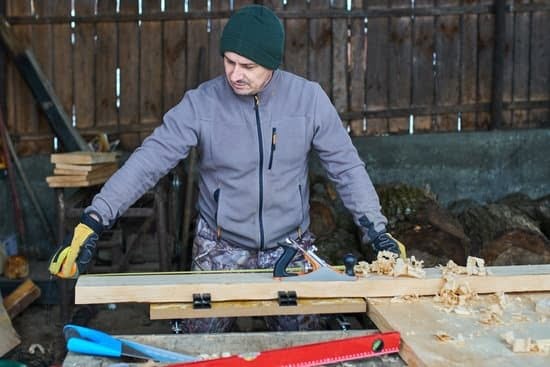Woodworking aprons are essential for any woodworker to protect their clothing and themselves from sawdust, splinters, and stains. Whether you are a seasoned professional or just starting out in the world of woodworking, having a sturdy apron can make a significant difference in your work efficiency and safety.
For those looking to add a personal touch to their workshop attire, creating a handmade woodworking apron could be the perfect solution. In this article, we will delve into the world of woodworking aprons and provide you with a free pattern to kickstart your DIY project.
The history of woodworking aprons dates back centuries, where craftsmen would wear leather or canvas garments to shield themselves from the rigors of their trade. Over time, woodworking aprons have evolved in design and functionality to meet the demands of modern woodworkers. From simple bib-style aprons to full-coverage smocks with multiple pockets and loops, there is a wide range of options available to suit different preferences and needs.
When it comes to making your own woodworking apron, you will need basic materials such as fabric, thread, and sewing tools. By choosing the right pattern that aligns with your style and requirements, you can create a customized apron that not only serves its practical purpose but also reflects your personality in the workshop.
In the following sections, we will guide you through the process of selecting the perfect pattern and provide step-by-step instructions on how to craft your very own woodworking apron from scratch.
History of Woodworking Aprons
Woodworking aprons have been a staple in the toolbox of woodworkers for centuries, with their roots dating back to ancient times. In the early days, woodworking aprons were simple garments made from leather or heavy-duty fabric to protect craftsmen from sharp tools and flying wood chips. These aprons were more practical than stylish, serving their primary purpose of keeping woodworkers safe during their craft.
Evolution of Woodworking Aprons
As woodworking techniques evolved and tools became more sophisticated, so did the design of woodworking aprons. The traditional leather aprons gave way to more lightweight and breathable fabrics like canvas or denim, making them more comfortable for long hours in the workshop. With advancements in sewing technology, woodworking aprons started featuring additional pockets and loops for storing tools and supplies, making them even more convenient for woodworkers.
Modern Trends in Woodworking Aprons
In today’s woodworking world, there is a wide range of woodworking apron styles and designs available to suit every craftsman’s needs. From full-length aprons with multiple pockets to shorter waist aprons for quick tasks, woodworkers can choose a design that best fits their work routine.
Some woodworking aprons even come with adjustable straps or cross-back designs for added comfort and support while working on intricate projects. The versatility and functionality of modern woodworking aprons make them an essential accessory for anyone serious about their craft.
Overall, the evolution of woodworking aprons showcases how this humble garment has adapted to meet the changing needs of craftsmen throughout history. Whether you prefer a classic leather apron for its durability or a modern canvas apron with extra storage options, having a woodworking apron is essential for protecting yourself while working with sharp tools and heavy machinery in the workshop.
With so many options available, finding the perfect woodworking apron pattern free online can help you create a personalized garment that suits your style and needs perfectly.
Materials Needed
When deciding to embark on a DIY woodworking apron project, it is essential to gather all the necessary materials before starting. Having the right supplies will ensure that your apron turns out sturdy and functional. Here is a list of materials needed to create a woodworking apron from scratch:
- Fabric: Choose a durable material that can withstand wear and tear, such as canvas or denim. The fabric should also be comfortable to wear for long periods.
- Thread: Opt for a strong thread that matches the color of your fabric to ensure seamless stitching and durability.
- Tools: Prepare basic sewing tools like scissors, pins, measuring tape, and a sewing machine if available. These tools will help you cut and assemble the fabric with precision.
- Trim: Consider adding trim or bias tape to give your woodworking apron a polished look. This optional embellishment can add personality to your creation.
By gathering these materials in advance, you set yourself up for success in creating a practical and stylish woodworking apron. Don’t forget to refer back to the woodworking apron pattern free guide for precise measurements and instructions as you begin crafting your masterpiece.
Choosing the Right Pattern
Woodworking aprons come in various styles and designs, each catering to different needs and preferences. When choosing the right pattern for your DIY woodworking apron project, it’s essential to consider factors such as functionality, comfort, and personal style.
Some popular styles include full-coverage aprons with multiple pockets for tools, half-aprons for lighter woodworking tasks, and cross-back aprons for better weight distribution. Whether you prefer a classic look or a more modern design, finding the perfect pattern is key to creating a woodworking apron that suits your needs.
One important aspect to consider when selecting a woodworking apron pattern is the level of protection it offers. For those working with sharp tools or handling heavy materials, a full-length apron with thick, durable fabric is ideal. Look for patterns that feature reinforced stitching and adjustable straps for added safety and comfort.
On the other hand, if you primarily work on smaller projects or need more mobility while woodworking, a shorter apron design might be more suitable. Consider your workspace setup and the type of projects you typically work on to determine the best style of apron for your needs.
In addition to functionality and protection, choosing a woodworking apron pattern that aligns with your personal style can make the DIY project even more enjoyable. Some patterns offer options for customization, allowing you to add unique features like extra pockets, loops for hanging tools, or even decorative elements.
By selecting a pattern that not only meets your practical requirements but also reflects your aesthetic preferences, you can create a woodworking apron that not only serves its purpose but also showcases your individuality in the workshop.
| Woodworking Apron Styles | Key Features |
|---|---|
| Full-Coverage Aprons | Multiple pockets for tools; Reinforced stitching; Adjustable straps |
| Half-Aprons | Lighweight design; Suitable for smaller projects; More mobility |
| Cross-Back Aprons | Better weight distribution; Comfortable fit; Modern design |
Step-by-Step Tutorial
Creating your own woodworking apron can be a rewarding project that not only protects your clothing but also adds a personal touch to your woodworking experience. Whether you are a seasoned woodworker or just starting out, having a durable and functional apron can make all the difference in keeping you safe and organized in the workshop. Here is a step-by-step tutorial on how to create a woodworking apron from scratch:
- Start by gathering all the materials needed for this project. You will need fabric, thread, scissors, measuring tape, sewing machine (optional), and any additional features you want to incorporate into your apron.
- Measure and cut the fabric according to the size of the apron you desire. Remember to leave room for seam allowances and any adjustments you may need to make during the sewing process.
- Sew the pieces of fabric together, following your chosen woodworking apron pattern. Make sure to reinforce seams and add any pockets or loops as needed. This is where your creativity can shine through.
Once you have sewn all pieces together, it’s time to add finishing touches to your woodworking apron. Trim any excess fabric, press seams for a crisp look, and double-check that all features are securely attached. Now you have a custom-made woodworking apron that suits your style and needs perfectly.
Don’t be afraid to experiment with different fabrics, colors, or designs to make your woodworking apron truly unique. With this free woodworking apron pattern and these detailed instructions, you can confidently tackle this DIY project and enjoy the benefits of having a handmade apron in your workshop. Happy crafting.
Tips and Tricks
Woodworking aprons are essential for any woodworking enthusiast as they help protect your clothes from stains, spills, and potential injuries while working with sharp tools. Making your own woodworking apron can be a fun and rewarding project, especially when you have the right guidance and tips to ensure its success.
One of the best ways to start is by finding a reliable woodworking apron pattern free of charge online. These patterns can serve as your blueprint in creating a custom-made apron that fits your style and preferences.
When embarking on your DIY woodworking apron project, it’s crucial to pay attention to the details and follow the steps carefully. One valuable tip is to prewash your fabric before cutting and sewing it to prevent any shrinkage after completing the apron.
Additionally, taking accurate measurements of yourself or the person who will wear the apron is essential to ensure a comfortable fit. Another helpful trick is to reinforce stress points like pockets and straps with double stitching for added durability.
As a beginner in crafting woodworking aprons, consider starting with simple designs before progressing to more complex styles. This will allow you to practice basic sewing techniques and gain confidence in handling different materials effectively. Experimenting with various fabrics, colors, and patterns can also add a personal touch to your woodworking apron, making it uniquely yours. Remember to take breaks when needed during the project to avoid rushing through the process and compromising on quality.
| Woodworking Apron Tips | Benefits |
|---|---|
| Prewash fabric before cutting | Prevents shrinkage |
| Reinforce stress points with double stitching | Enhances durability |
| Start with simple designs for practice | Builds sewing skills |
Customization Options
Adding Pockets for Convenience
When it comes to woodworking aprons, having pockets can make a world of difference in terms of convenience. Not only do pockets provide storage for small tools and accessories, but they also keep them within easy reach while you work on your projects. Depending on your needs, you can add various sized pockets to accommodate different items. Consider including larger pockets for items like measuring tapes or small notebooks, while smaller pockets are perfect for holding screws, nails, or pencils.
Incorporating Loops for Tools
Another way to customize your woodworking apron is by incorporating loops for tools. These loops can be designed to hold specific tools securely in place, preventing them from getting lost or misplaced during work.
Whether you need a loop for a hammer, screwdriver, pliers, or any other tool, make sure to measure and position the loops accordingly on your apron. By having designated spots for your most frequently used tools, you can optimize your workflow and stay organized while working on your woodworking projects.
Additional Features for Versatility
In addition to pockets and loops, there are other handy features you can consider adding to personalize your woodworking apron further. For example, adjustable straps allow you to customize the fit of the apron to ensure maximum comfort and mobility while working. You could also include a towel loop or a clip for holding safety glasses or ear protection.
Reflect on your individual needs and preferences as a woodworker when deciding which customization options will enhance the functionality of your apron. Remember that these features not only add personality to your apron but also contribute to its practicality in the workshop.
Safety Considerations
When it comes to woodworking, safety should always be a top priority. Working with sharp tools and heavy machinery can pose risks if proper precautions are not taken. This is where a woodworking apron plays a crucial role in ensuring the safety of the woodworker. A well-made apron not only protects your clothes from sawdust and debris but also provides an added layer of protection for your body against potential accidents.
One of the key benefits of wearing a woodworking apron is that it helps prevent injuries caused by sharp tools or flying wood particles. The sturdy fabric of the apron can act as a barrier between your skin and any harmful objects that may come into contact during the woodworking process.
Additionally, many woodworking aprons come with reinforced pockets and loops to store essential tools within easy reach, reducing the chances of reaching across dangerous machinery to grab what you need.
Whether you are a seasoned woodworker or just starting out in the craft, investing in a quality woodworking apron can make a world of difference in your safety and overall experience in the workshop. By following a free woodworking apron pattern and customizing it to fit your needs, you can create a durable and protective garment that will not only keep you safe but also add efficiency to your work.
Don’t underestimate the importance of safety when working with woodworking tools – a proper apron is more than just an accessory, it’s a vital piece of protective gear.
Conclusion
In conclusion, owning a woodworking apron is essential for any woodworker, providing protection from dust, splinters, and sharp tools while keeping your clothes clean. Choosing to make a handmade woodworking apron adds a personal touch to your workspace and allows for customization according to your specific needs. By following the step-by-step tutorial provided in this article and utilizing the free woodworking apron pattern, you can create a practical and personalized apron that will enhance your woodworking experience.
Throughout history, woodworking aprons have evolved from simple garments to functional accessories, reflecting the changing needs of woodworkers over time. Today, with a variety of materials and patterns available, woodworkers can choose an apron that suits their style and preferences. Whether you prefer a traditional design or a more modern look, there are options to fit every taste and requirement.
It is important to remember safety considerations when working with woodworking tools. A proper woodworking apron not only protects your clothing but also provides an extra layer of defense against potential injuries. By taking the time to create your own woodworking apron using the free pattern provided in this article, you are not only investing in your safety but also honing your skills as a DIY enthusiast.
So why wait? Grab your materials and get started on crafting your very own woodworking apron today.
Frequently Asked Questions
How Do You Make an Apron Without a Pattern?
Making an apron without a pattern can be done by simply using your measurements to cut out the fabric. Start by measuring your waist, hips, and desired length of the apron. Then, cut out a rectangle for the body of the apron and two straps to tie around your waist.
How Do You Make an Apron in 10 Minutes?
If you want to make an apron in just 10 minutes, a quick no-sew option is ideal. You can transform a kitchen towel into an apron by folding it in half lengthwise, cutting a semi-circle at the fold for your head to go through, and then attaching ribbon or string to each corner as ties around your waist.
How Do You Make a No Sew Apron?
Creating a no-sew apron requires some creativity and resourcefulness. One easy method is using an oversized t-shirt – simply cut off the sleeves and neckline, then make a slit down the center of the shirt starting from the neckline. This will create two separate pieces which can be tied behind your back to form an apron.

Hi everyone! I’m a woodworker and blogger, and this is my woodworking blog. In my blog, I share tips and tricks for woodworkers of all skill levels, as well as project ideas that you can try yourself.





